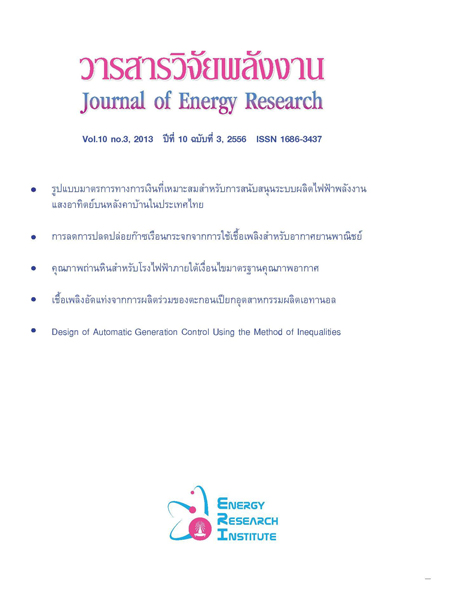เชื้อเพลิงอัดแท่งจากการผลิตร่วมของตะกอนเปียกอุตสาหกรรมผลิตเอทานอล
Main Article Content
Abstract
วัตถุประสงค์ของงานวิจัยนี้เพื่อทำการศึกษาและพัฒนากากตะกอนเปียกจากน้ำเสียของกระบวนการผลิตเอทานอลมาใช้ในรูปแบบเชื้อเพลิงอัดแท่งและทำการเพิ่มคุณภาพโดยการนำไปผสมกับชีวมวล 3 ชนิด (เปลือกมังคุด เปลือกทุเรียนและกะลามะพร้าว) เพื่อเพิ่มประสิทธิภาพและคุณสมบัติของเชื้อเพลิงอัดแท่ง โดยงานวิจัยนี้แบ่งเป็น 3 ส่วนหลัก คือ การศึกษาและการผลิตเชื้อเพลิงอัดแท่งจากกากตะกอนเปียกผสมร่วมกับชีวมวลในอัตราส่วนที่แตกต่างกัน ต่อไปทำการวิเคราะห์หาอัตราส่วนที่เหมาะสมในการผลิตเชื้อเพลิงอัดแท่งจากตะกอนเปียกที่มีคุณภาพมากที่สุดโดยที่มีกากตะกอนเปียกเป็นส่วนผสมหลักและสุดท้ายคือวิเคราะห์ต้นทุนในการผลิตของเชื้อเพลิงอัดแท่งและวิเคราะห์ผลตอบแทนทางเศรษฐ์ศาสตร์ โดยจากการวิเคราะห์คุณสมบัติทางด้านพลังงานของเชื้อเพลิงจากตะกอนเปียกบริสุทธิ์ มีค่าความร้อน 3,851.3 cal/g ปริมาณเถ้า 34.3% คาร์บอนคงตัว 30.2% สารที่ระเหยได้ 33.2% และมีความชื้น 5.3% ซึ่งถือว่ายังไม่อยู่ในเกณฑ์ที่จัดว่าเป็นคุณสมบัติทางด้านเชื้อเพลิงที่ดีจึงจำเป็นต้องมีการพัฒนาและเพิ่มคุณภาพของเชื้อเพลิงอัดแท่งจากตะกอนเปียกให้มากขึ้นเพื่อนำไปใช้ทดแทน ถ่านและฝืน โดยในงานวิจัยนี้ผู้วิจัยได้นำชีวมวล (เปลือกมังคุด เปลือกทุเรียนและกะลามะพร้าว)เข้ามาผสมร่วมเพื่อเพิ่มคุณภาพของเชื้อเพลิงอัดแท่ง ใน 5 อัตราส่วน 9:1, 8:2, 7:3, 6:4 และ 5:5 ทั้ง 3 ตัวอย่าง โดยจากผลวิเคราะห์ทำให้ทราบว่าอัตราส่วนผสมที่ดีที่สุดโดยที่มีกากตะกอนเปียกเป็นตัวผสมหลักคือ 5:5 ทั้ง 3 ตัวโดยมีค่าความร้อนและปริมาณคาร์บอนคงตัวเพิ่มมากขึ้นแปรผันตรงตามอัตราส่วนผสมของชีวมวลที่เพิ่มขึ้น และยังทำให้ปริมาณเถ้าและสารระเหยน้อยลงตามอันดับ โดยเชื้อเพลิงอัดแท่งจากตะกอนเปียกผสมร่วมกับกะลามะพร้าวให้ค่าความร้อนสูงสุด เปลือกมังคุด และเปลือกทุเรียน ตามอันดับ
วิเคราะห์ต้นทุนในการผลิตของเชื้อเพลิงอัดแท่งและวิเคราะห์ผลตอบแทนทางเศรษฐ์ศาสตร์ของเชื้อเพลิงอัดแท่งจากตะกอนเปียกผสมร่วมกับชีวมวลในอัตราส่วน 5:5 ที่เป็นอัตราส่วนที่เชื้อเพลิงอัดแท่งมีคุณสมบัติทางด้านเชื้อเพลิงดีที่สุดทำให้ทราบว่าตะกอนเปียกมีความคุ้มค่าในการลงทุนสูงและสามารถคืนทุนในระยะเวลาอัน จากผลการวิจัยนี้สามารถนำไปส่งเสริมและพัฒนาการนำวัสดุของเสียเหลือทิ้งจากการผลิตและการบริโภคทางการเกษตรนำมาใช้ประโยชน์อย่างคุ้มค่าและเป็นอีกหนึ่งทางที่ช่วยลดปัญหาสิ่งแวดล้อมได้อีกทางหนึ่ง
BRIQUETTE FUEL FROM CO-PRODUCTION OF ETHANOL INDUSTRIAL WET CAKE AND BIOMASS
Akekaruk Kitipattaworn1, Prasert Reubroycharoen2 and Walairat Uttamaprakorm3
1311/22 Songprapa rd. Seekan Donmuang Bangkok.
2,3Energy Research Institute, Chulalongkorn University.
This objective of this research was to study and develop the biofuel or briquette fuel from wet cake of the wastewater in ethanol industrial and improve the quality of briquette fuel by adding the other biomass that come from the hard shell of fruit (mangosteen shell, durian shell and coconut shell) to improve the efficiency and property of briquette fuel. This research was separated in to 3 parts. The first was study and make the briquette fuel co-production from wet cake of ethanol industrial and fruit shell in different ratio. The second part was analyzing the produced briquette fuel that have the best quality with the wet cake are the main component. And the last was economy analysis. From the result, The briquette fuel from 100% wet cake from wastewater of ethanol industrial has the heating value 3,851.3 cal/g, Ash 34.3% Fixed carbon 30.2%, Volatile matter 33.2% and moisture 5.3% with this parameter the wet cake does not meet the quality standard, it need to improve and develop to meet standard for the makeup of coal and firewood. In this research, the researcher was added the biomass (mangosteen shell, durian shell and coconut shell) to the briquette fuel from wet cake in 5 ratios (9:1, 8:2, 7:3, 6:4 and 5:5) of 3 samples. From the results, show the best ratio was the 5:5 all three samples with the highest heating value and fixed carbon with the addition biomass in the sample and also decreases the ash content and volatile matter. The highest heating value was briquette fuel co-production with coconut shell and follow with mangosteen shell and durian shell. From the economic analyze the briquette fuel at ration 5:5 that it have the value of investment and a payback in less time. The results of this research can contribute to the promotion and development of the waste materials from the production and consumption of agricultural utilized cost-effectively and is another way to reduce the environmental problems the other way.

